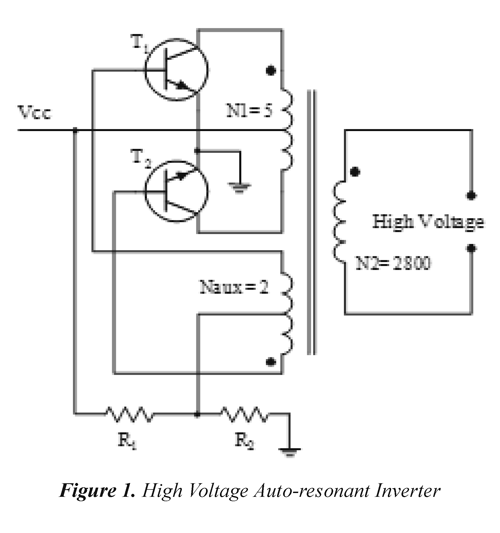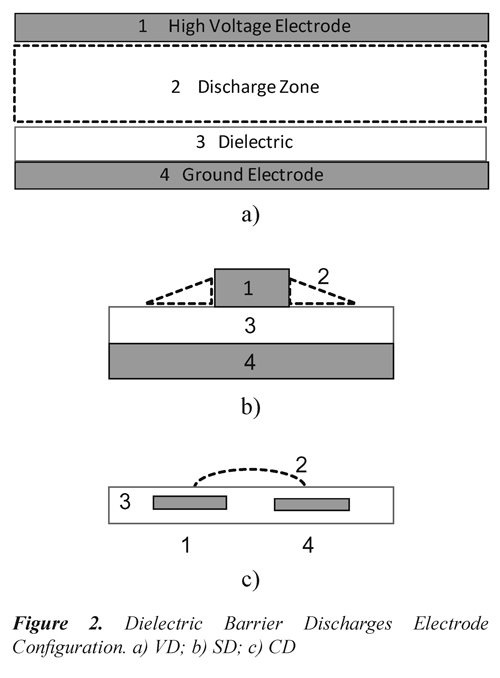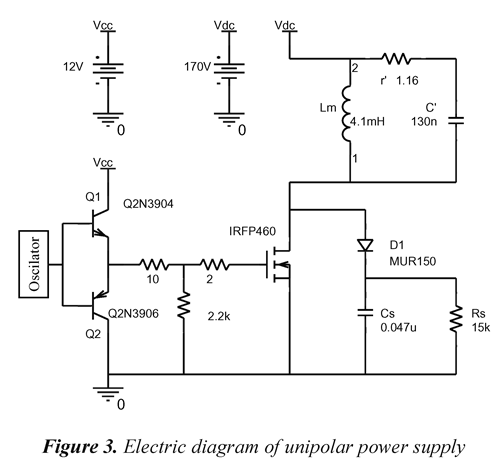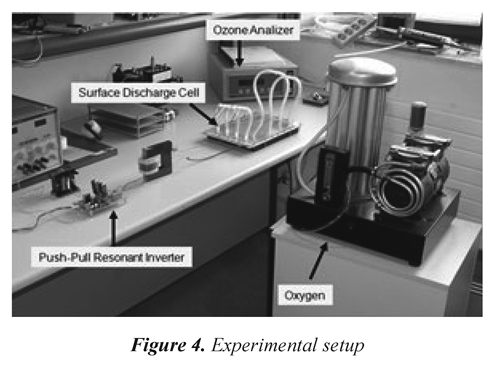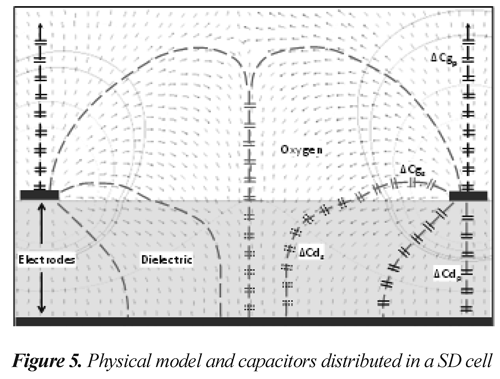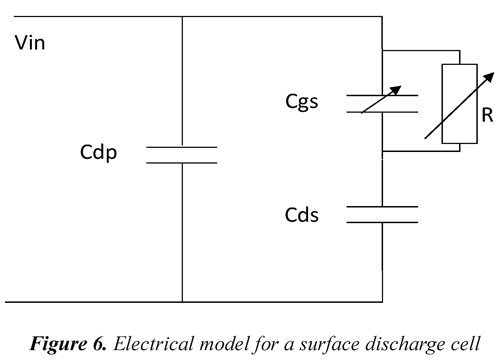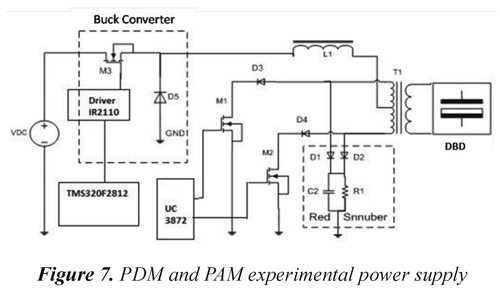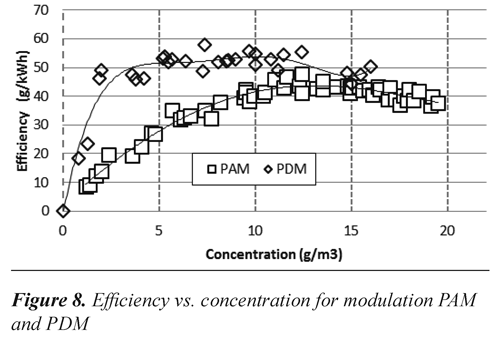Services on Demand
Journal
Article
Indicators
-
 Cited by SciELO
Cited by SciELO -
 Access statistics
Access statistics
Related links
-
 Cited by Google
Cited by Google -
 Similars in
SciELO
Similars in
SciELO -
 Similars in Google
Similars in Google
Share
Ingeniería y competitividad
Print version ISSN 0123-3033
Ing. compet. vol.15 no.2 Cali July/Dec. 2013
Developments of ozone generation using dielectric barrier discharge at the Universidad del Valle
Desarrollos de la generación de ozono por descarga de barrera dieléctrica en la Universidad del Valle
Diego F. Echeverry-Ibarra
Grupo de Investigación en Alta Tensión, Escuela de Ingeniería Eléctrica y Electrónica, Universidad del Valle, Cali, Colombia
E-mail: diego.echeverry@correounivalle.edu.co
Eje temático: Electrical and electronic engineering / Ingeniería eléctrica y electrónica
Recibido: 22 de Abril de 2013
Aceptado: 23 de Agosto de 2013
Abstract
This paper presents the research results related to ozone technology using dielectric barrier discharge DBD, obtained at the Universidad del Valle. Particular emphasis is placed on increasing efficiency, the modeling of the surface dielectric barrier discharge generator and the control technique which modifies the relation production vs. efficiency of the generators. Finally, the ozone applications worked at the university are presented. The current state of these developments is promising for ozone technology industrialization and to develop ozone applications in Colombia.
Keywords: Ozone Generation, Dielectric Barrier Discharge, Resonant Push-Pull Inverter, Surface Discharge, Efficiency.
Resumen
Este artículo presenta los resultados de investigación relacionados a la tecnología del ozono por descarga de barrera dieléctrica (DBD), obtenidos en la Universidad del Valle. Se enfatiza en el aumento de la eficiencia, el modelado de un generador DBD superficial y en una técnica de control que modifica la relación producción vs eficiencia de los generadores. Finalmente, se presentan las aplicaciones del ozono investigadas en la Universidad. El estado actual es prometedor para industrializar la fabricación de generadores de ozono y para impulsar las aplicaciones del ozono en Colombia.
Palabras clave: Generación de Ozono, Descarga de Barrera Dieléctrica, Inversor Resonante Push-Pull, Descarga Superficial, Eficiencia.
1. Introduction
Due to awareness of environmental conservation and the potential of the role ozone plays in this, ozone technology is expanding and being studied in an increasing manner (Loeb, 2011). Researchers at the Universidad del Valle have been working on ozone applications since 2000, when talcum powder was sterilized with ozone for the Jhonson and Jhonson company (Garzón, 2000); and since 2001 when the first ozone generation prototype was built (Echeverry et al, 2001). Figure 1 shows the circuit of the first power supply to generate ozone developed at Universidad del Valle. The circuit is a high voltage auto-resonant inverter. At the present time, there are significant contributions for increasing efficiency of ozone generation systems and performance design (Echeverry, 2008;Cifuentes, 2013), as well as advances in promising applications for our country (Muños et al, 2010; Borrero et al 2008).
Ozone technology in Colombia has been primarily commercialized by small companies and focused on the applications of domestic and semi-industrial use. For industrial applications, companies are shipping equipment from other countries. This import of equipment has prompted academic institutions and especially the Universidad de Valle, to lead research into the gathering and generation of scientific and technical knowledge in the area of ozone generators and their possible applications. From the academic point of view, it also plays an important role in the achievement of human capital development at different levels of higher education. However, very little work has been done with this technology in comparison to other countries.
There are several processes for ozone generation; however, this paper addresses the high-frequency dielectric barrier discharge (DBD) due to its greater potential uses in industry. Ozone generators for DBD can be grouped into three types according to the arrangement of the electrodes and the dielectric: VD (Volume Discharge), SD (Surface Discharge) and CD (Coplanar Discharge). VD arrangements are the most studied and used, see Figure 2; however, SD arrangements can provide greater efficiencies, but they have not been widely studied. DBD generators are suitable for achieving high ozone concentrations.
This paper presents the evolution and development of ozone generation systems by dielectric barrier discharge achieved at the Universidad del Valle, highlighting the contributions on increasing the efficiency and modeling of a surface discharge generator. Furthermore, ozone applications are described and shown.
2. Development of ozone generation systems
The research in ozone generation at the Universidad del Valle has focused primarily on the development of the DBD cells in order to take advantage of the power electronics to increase efficiency which has greater control possibilities (Echeverry et al, 2006; Echeverry et al, 2008; Echeverry, 2008; Cifuentes, 2013). In recent years, there have been works published on increasing efficiency and in operating ozone generators in state of resonance (Alonso et al, 2004; Echeverry, 2008; Cifuentes, 2013). From an engineering standpoint, experiments have been conducted to determine the effect of design and operation parameters of the DBD cells with respect to the production of ozone and its efficiency (Echeverry et al, 2001; Echeverry et al, 2008; Echeverry, 2008; Bazurto, 2011). In Echeverry et al, 2008, a VD cell is used where a film of silver nitrate is a high-voltage electrode and is adhered to the dielectric, which can reduce costs and facilitate its construction.
DBD cells are primarily energized with AC sinusoidal signals, pulses of short duration, and unipolar signals. The pulses of short duration (approximately 50 ns) allow high efficiencies in the ozone production; however, the implementation of the power supply is very complex and low ozone concentration is obtained due to the low repetition rate of the pulses. Unipolar signals are useful for small ozone generators where simple and inexpensive circuits are required. In Echeverry et al, 2008, a short unipolar signal [µs] is generated by a repetition frequency between 1kHz and 50kHz and is suitable for low power applications. Figure 3, shows the short unipolar signal circuit developed at the Universidad del Valle. This circuit allows ozone production adjusting per period variations, maintaining the width of the fixed pulse. The main drawback is that the switching device must support a minimum voltage Vds (drain-source Voltage) of approximately twice the DC bus voltage; the principle of operation of the electric source implemented in this work is similar to that of the Flyback DC-DC converters. During the active time, the energy is transferred from the high voltage transformer to the DBD cell. During the inactive time, the stored energy oscillates between the high voltage transformer (Lm) and the DBD cell (C´).
In the case of sinusoidal waves, the predominant trend is for the use of high frequency (5-20 kHz). High frequency systems require greater heat dissipation accumulated in the cell and it requires alternatives to reduce the switching losses in power semiconductors and high frequency transformer copper losses. These problems are reduced in the supply by operating in a state of resonance between the transformer and the cell discharge (Echeverry, 2008 ). In Alonso et al, 2004; Echeverry, 2008, push-pull autoresonant power supply is designed and implemented.
In the last decade, at a national level, research on high frequency ozone generation is joining forces in order to improve development in the operation of these equipments into higher energy efficiency, reducing costs, increasing production per unit cell volume, developing methods to vary the production of ozone maintaining certain performance conditions and achieving high concentrations (Echeverry et al, 2006; Echeverry, 2008;Cifuentes, 2013). At the international level, Huang et al, 2012, analyzed the effect of electrical frequency on ozone concentration and efficiency of a DBD generator. Additionally in Aba'aNdong et al, 2013, performed experimental characterization of a surface DBD powered by pulses of very short duration in terms of electrical and geometric parameters. In (Stryczewska et al, 2013) performed a review of the power supplies and proposed some solutions with respect to the type of high voltage transformer, resonant inverters and DC-AC inverter.
2.1 Electrical modeling and raising the efficiency in ozone generation
Echeverry, 2008, approached the study of dielectric barrier discharge ozone generation from a physical-chemical and electrical standpoint, and proposes a methodology to increase efficiency in the ozone production. Figure 4, shows an image of the experimental setup. This research proposes, on the one hand, a method based on the distribution and paths of the electric field lines to identify the present capacitances in the DBD generator and, on the other hand, a methodology for designing the resonant transformer is introduced in order to calculate magnetic length and core area depending on the number of coils in the primary, by ensuring resonance state between the transformer and ozone generator at a predetermined frequency of operation. Parameters such as flux density, gap width, and input voltage can be adjusted to select a specific core. During the process, the frequency of operation can be adjusted keeping the output voltage constant. The only immovable parameters for the transformer design are the DBD cell capacitance and the maximum voltage in the secondary.
A method based on electrical charges distribution and the energy stored for calculating and modeling of DBD surface cell capacitance was used, by means of finite element simulation software. This method of electrical modeling, considers that there are an infinite number of small volume differentials arranged in the paths of the electric field lines between the high voltage electrode and the ground electrode. These volume differentials are represented as a series circuit of capacitors (?C) in each region of the DBD cell. Each path of electric field lines depends on the materials and geometry of the DBD cell. The series capacitors of a determined path can be modeled as a single capacitor of appropriate value. Figure 5, shows the physical model implemented in Maxwell software, where the capacitors distributed in a SD cell can be observed. Figure 6, shows the electrical model proposed for a single electrode of a SD cell that can be used in electrical circuit simulation programs. In the circuit shown in figure 6, Cdp is the equivalent capacitance between the bottom surface of the discharge electrode and the ground electrode; Cds, the capacitance of the dielectric located in series with Cgs capacitances of the gap; R, is the equivalent resistance that models the power consumed in the discharge; the parasitic capacitance Cgp is neglected in the model.
Measuring each of the internal capacitances of the SD cell is impossible to perform experimentally due to the mutual effect capacitance between them; however, the total capacitance of the cell can be measured. In this research, the electric field simulation by the finite element was used to calculate the equivalent capacitance Cpd, equivalent capacitances Cgs and Cds, and total capacitance of the cell Ct. The total capacitance calculated of the cell was 17 pF. This result is consistent with the experimentally measured capacitance, which was 19 pF; presenting less than 15% difference in the capacitance value; however, this difference would generate only an error of 7% in the calculation of the resonant frequency.
The methodology proposed in (Echeverry, 2008) allowed the construction of an oxygen-fed surface DBD ozone generator, energized with a push-pull resonant inverter. The measured data is shown in Table 1, indicating the point of maximum efficiency operation of the ozone generation prototype constructed. Where Vp is the peak voltage in the cell, Pf, Pt and Psd are powers measured in the input supply, the transformer input and the cell respectively. C and P are the concentration and production. While ?f, ?t, and ?sd are efficiencies calculated from power measured in the input of supply, in the transformer input terminals, and the cell respectively.
Quantifying the efficiency is performed by the amount of ozone produced per unit energy consumed, obtaining values higher than 320 g/ kWh in the cell and 166g/kWh for the entire system. However, it is necessary to analyze the behavior of the system under pilot scale conditions. The highest production of ozone measurement in the cell was 3.1 g/h with an efficiency of 221 g/ kWh and concentration of 34.7 g/m3, at this point of operation the cell is heated and is required to have a cooling system to decrease the ozone decomposition.
2.2 Modulation techniques and its effect on the efficiency
Each ozone generator with fixed operating conditions can be characterized by the ratio of efficiency vs. concentration. The results obtained in (Kitayama&Kuzumoto, 1997) show that the efficiency in a VD cell is at maximum if the ozone generator is operated at optimum value of reduced electric field (E / N = 100Td). In (Echeverry, 2008) it is presented that the efficiency vs. concentration curve can be optimized by operating the cell at constant voltage, unlike the systems that use pulse amplitude modulation (PAM) which require variation of the voltage in order to allow ozone concentration adjustment. To accomplish this, in (Cifuentes, 2013) pulse-density modulation (PDM) was implemented for supplying the VD cell at a fixed optimum voltage. By using this technique, the electric field reduced in the discharge cell is close to optimal in all operating set-points. The fixed optimum voltage adjusted for the PDM modulation was determined from the efficiency vs. voltage curve with the PAM modulation. Increased efficiency was achieved in a large percentage of operating set-points in the ozone generation system. Figure 7 shows the experimental supply scheme used. This circuit is a current feed auto-resonant push-pull inverter, with an UC3872; The DC-DC converter is a buck type topology which controls the DC current applied to the inverter; it implements a DSP (TMS320F2812) that runs the control algorithm of the buck converter.
Figure 8 shows the efficiency vs. concentration curve obtained with the PAM and PDM techniques. With the PDM technique, the efficiency will quickly increase as concentration increases and reaches an efficiency value of 50 g/ kWh at a concentration as low as 4 g/m3. Also, it remains almost constant for higher concentrations. The PDM technique achieves an important efficiency in the low concentration range and higher efficiency than that of the traditional PAM modulation method. This development is very useful in applications requiring adjustable ozone concentrations.
3. Research on ozone applications
Historically, most ozone applications have been used in water potabilization; however, in recent years many promising applications have emerged, such as water sewage treatment, food preservation, medical uses, processes in food industry, among others (Loeb, 2011; Galvis et al, 2005;Borrero et al, 2008; Muños et al, 2010).
In Colombia, ozonation systems are a costly technology; at an industrial scale it has been mainly applied in bottled water treatment plants, for example at Postobón Company in 1991. To the research level there are very few studies that have been conducted. At the Universidad del Valle, progress has been made in ozone sterilization of powder for the Johnson & Johnson company(Garzón, 2000); the High Voltage Research Group (GRALTA) and CINARA Institute have evaluated the use of ozone in a pilot plant for water treatment in the city of Cali (Galvis et al, 2005), and at a rural hospital (Echeverry et al; 2006). At the Universidad del Valle, ozone has also been used for swimming pool water treatment (Borrero et al, 2008). All these studies have shown the effectiveness of ozone, but also need to be optimized in order to reduce the costs of these processes which can lead to industrial scale use.
The ozone generator prototype developed by (Echeverry, 2008) was used in a trial of leachate ozonation. An ozonation period of 30 minutes at 2.8 g/h and 30 g/m3 was used. The leachate showed physical change, which can be an indicator of an increase in biodegradation. The GAOX research group included ozonation as a pretreatment in the project "Sustainable Biofuels for North Andean Countries", where vinasse was ozonized to increase biodegradation in methane production process (Muños et al, 2010).
4. Conclusions
The evolution in the development of ozone generation systems by dielectric barrier discharge in Colombia shows significant progress in the field of research and laboratory scale studies. However, it is necessary to link these developments to the production and commercial sectors to evaluate pilot and industrial scale systems. There is a clear trend towards high frequency resonant supplies. The high-frequency resonant power supply and surface discharge cell exhibit characteristics which can achieve high efficiencies. Electronic developments have allowed, among other things, the incorporation of modulation techniques (eg PDM technique) for varying the ozone concentration and increasing production efficiency.
A methodology to increase efficiency by DBD ozone generation system was developed. This methodology examines the electric field distribution to estimate the values of capacitance of a surface discharge cell and proposes a method for designing high-frequency transformer, which allows the system to operate in a state of resonance. However, it is necessary to explore new techniques in order to reduce costs and increase efficiency, both at the power supply and in the discharge cell.
Research groups have a basic knowledge sufficient to address ozone applications in various fields such as medicine, water sewage treatment, and food processing. All these uses are promising for the country.
5. Acknowledgments
The author would like to thank Colciencias and the Universidad del Valle, which provided the financial support for his doctoral study. The author also acknowledges Agricultural Research for Development (ARD-Colombia) for funding the project "Development on Ozone Disinfection Transfer" and the Directorate for Development and Cooperation of the Swiss Government for funding the project titled "Sustainable Biofuels for North Andean Countries".
6. References
Aba'aNdong, A.C., Zouzou, N., Benard, N. & Moreau, E. (2013). Geometrical optimization of a surface DBD powered by a nanosecond pulsed high voltage. Journal of Electrostatics ,71 (3) 246-253. [ Links ]
Alonso, J., Garcia, J., Calleja, A. Ribas, J., & Cardesin, J. (2004/10/3-7). Analysis, Design and Experimentation of High Voltage Power Supply for Ozone Generation based on the Current-Fed Parallel-Resonant Push-Pull Inverter. In IEEE. Proc. of IEEE Industry Applications Society Meeting (IAS) (pp. 2687-2693). New York: IEEE. [ Links ]
Bazurto, A. (2011). Efecto de la longitud de los electrodos en la producción de ozono de un generador de ozono dbd de placas paralelas . Undergraduate Thesis. School of Electrical and Electronic Engineering, Universidad del Valle, Cali, Colombia. [ Links ]
Borrero, P., Echeverry, D., & Aponte, G. (2008). Ozonización del agua de piscinas: una alternativa al método tradicional de cloración. Tecnura , 11 (22), 5-15. [ Links ]
Cifuentes-Rojas, W.A. (2013). Efecto de la modulación de la onda de potencia en la curva característica de eficiencia de un generador de ozono . Master's Thesis. School of Electrical and Electronic Engineering, Universidad del Valle, Cali, Colombia. [ Links ]
Echeverry, D., Cadavid, H., Alonso, J.M., Aponte, G., & Gálvis, A. (2008). Experimental results of a cost-effective ozonator for water treatment in colombia. Ozone Science & Engineering , 30 (3), 202-209. [ Links ]
Echeverry, D., Cadavid, H., Aponte, G., Andrade, F., & Alonso, J.M. (2006). Inversor de Alto Voltaje y Alta Frecuencia Para Aplicaciones en Desinfección de Agua con Ozono. In SAAAEI. XIII Seminario Anual de Automática, Electrónica Industrial e Instrumentación, SAAEI06 . Gijón, España: Universidad de Oviedo. [ Links ]
Echeverry, D., Carmona, F., & Aponte, G. (2001). Diseño y Construcción de un Generador de Ozono por Descarga Corona. Energía y Computación , 10 (2), 27-32. [ Links ]
Echeverry-Ibarra, D. (2008). Aumento de la eficiencia del sistema de descarga de barrera dieléctrica aplicado en la generación de ozon o. Doctoral Thesis. School of Electrical and Electronic Engineering, Universidad del Valle, Cali, Colombia. [ Links ]
Galvis, A., Aponte, G., Echeverry, D., González, M., & Cardona, D. (2005). Evaluación del funcionamiento de un Generador de Ozono a escala piloto en la desinfección de agua para consumo humano. Ingeniería y Competitividad , 7 (1), 65-72. [ Links ]
Garzón, J. (2000). Esterilización de talco con ozono . Undergraduate Thesis. Faculty of Engineering, Universidad del Valle, Cali, Colombia. [ Links ]
Huang , G., Wang, T., Timoshkin, I., MacGregor, S., Given, M. & Wilson, M. (2012). Investigation of ozone generation using dielectric barrier discharges at 50 Hz, 2.6 kHz and 20 kHz. In Proceedings of the XIX International Conference on Gas Discharges and Their Applications . (pp. 650-653). Beijing, China. Recovered 2015/01/20 http://strathprints.strath.ac.uk/41619/ [ Links ]
Kitayama, J., & Kuzumoto, M. (1997). Theoretical and Experimental Study on Ozone Generation Characteristics of an Oxygen-Fed Ozone Generator in Silent Discharge. Journal of Physics D: Applied Physics , 30 (17), 2453-2461. [ Links ]
Loeb, B. (2011). Ozone: science & engineering: Thirty-Three Years and Growing. Science and Engineering , 33 (4), 329-342. [ Links ]
Muños, Y., Machuca, F., Caicedo, N., & Echeverry, D. (2010). Treatment of crude vinasse from cane industry by ozone. In 16th International Conference on Advanced Oxidation Technologies for Treatment of Water, Air and Soil. San Diego (CA). [ Links ]
Stryczewska, H., Jakubowski, T., Kalisiak, S., Gizewski, T., & Pawlat, J. (2013). Power Systems of Plasma Reactors for Non-Thermal Plasma Generation. Journal of Advanced Oxidation Technologies , 16 (1), 52-62. [ Links ]

Revista Ingeniería y Competitividad por Universidad del Valle se encuentra bajo una licencia Creative Commons Reconocimiento - Debe reconocer adecuadamente la autoría, proporcionar un enlace a la licencia e indicar si se han realizado cambios. Puede hacerlo de cualquier manera razonable, pero no de una manera que sugiera que tiene el apoyo del licenciador o lo recibe por el uso que hace.













